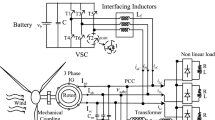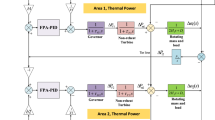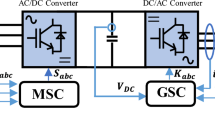Abstract
Power system stabilizers (PSSs) are extensively used in generator units to enhance the transient stability of the power system. Hence, optimal tuning and placement of the parameters of PSS are crucial for the efficiency of the stabilizer. Researchers have been proposed many methods for optimizing such parameters. In this paper, the Crow search algorithm (CSA), which is based on the intelligence of crows, was employed in a single-machine infinite-bus (SMIB) system to determine the optimum parameters of the PSS. Modeling and simulation of the SMIB and designing of PSS were made by MATLAB/Simulink. PSSs are designed to minimize low-frequency oscillations such as power angle, rotor speed, and field current deviation following a large disturbance. Our objective in this study is the minimization of the rotor speed deviation. The results of the simulations proved the effectiveness and robustness of the optimization process compared to other metaheuristic algorithms such as particle swarm optimization (PSO) and genetic algorithm (GA). When compared to the performance attained by the GA-based and PSO-based PSS controller designs, the simulations show that the CSA-based PSS delivers a far better dynamic response when the system is disrupted. The CSA-based PSS settles 48.1% faster than the PSO-based PSS and 55.7% faster than the GA-based PSS. CSA has just 2 parameters to adjust, making it much easier to implement than other methods. These parameters for PSO and GA are 4 and 6. When CSA-based PSS is used in the SMIB system, overshoot and low-frequency oscillations are also significantly reduced compared to other methods.










Similar content being viewed by others
References
Lu J, Nahrir MH, Pierre DA (2001) A fuzzy logic-based self-tuning power system stabilizer optimized with a genetic algorithm. Electr Power Syst Res 60(2):77–83. https://doi.org/10.1016/S0378-7796(01)00170-5
Abido MA, Abdel-Magid YL (1997) Tuning of a fuzzy logic power system stabilizer using genetic algorithms. In: Proc IEEE Conf Evol Comput ICEC, pp. 595–599, https://doi.org/10.1109/icec.1997.592380
Kundur P, Balu NJ, Lauby MG (1994) Power system stability and control. McGraw-Hill Education
Anderson PM, Fouad AAA (1977) Power system control and stability. Iowa State University Press
Fereidouni AR, Vahidi B, Hoseini Mehr T, Tahmasbi M (2013) Improvement of low frequency oscillation damping by allocation and design of power system stabilizers in the multi-machine power system. Int J Electr Power Energy Syst 52(1):207–220. https://doi.org/10.1016/j.ijepes.2013.03.030
Lee Y-C, Chi-Jui Wu (1995) Damping of power system oscillations with output feedback and strip eigenvalue assignment. IEEE Trans Power Syst 10(3):1620–1626. https://doi.org/10.1109/59.466479
Da Cruz JJ, Zanetta LC (1997) Stabilizer design for multimachine power systems using mathematical programming. Int J Electr Power Energy Syst 19(8):519–523. https://doi.org/10.1016/S0142-0615(97)00023-9
Zanetta LC, Da Cruz JJ (2005) An incremental approach to the coordinated tuning of power systems stabilizers using mathematical programming. IEEE Trans Power Syst 20(2):895–902. https://doi.org/10.1109/TPWRS.2005.846111
Abido MA (2000) Robust design of multimachine power system stabilizers using simulated annealing. IEEE Trans Energy Convers 15(3):297–304. https://doi.org/10.1109/60.875496
Hsu Y-Y, Hsu C-Y (1986) Design of a proportional-integral power system stabilizer. IEEE Trans Power Syst PWRS1(2):46–52
Hsu YY, Liou K (1987) Design of self-tuning PID power system stabilizers for synchronous generators. IEEE Trans Energy Conversion EC-2(3):343–348
Sil A, Gangopadhyay TK, Paul S, Maitra AK (2009) Design of robust power system stabilizer using H∞ mixed sensitivity technique. In: 2009 Int Conf Power Syst ICPS ’09, https://doi.org/10.1109/ICPWS.2009.5442746
Gibbard MJ (1991) Robust design of fixed-parameter power system stabilizers over a wide range of operating conditions. IEEE Trans Power Syst 6(2):794
Pierre DA (1987) A perspective on adaptive control of power systems. IEEE Trans Power Syst 2(2):387–395. https://doi.org/10.1109/TPWRS.1987.4335139
Zhang Y, Chen GP, Malik OP, Hope GS (1993) An artificial neural network based adaptive power system stabilizer. IEEE Trans Energy Convers 8(1):71–77. https://doi.org/10.1109/60.207408
Soliman M, Elshafei AL, Bendary F, Mansour W (2009) LMI static output-feedback design of fuzzy power system stabilizers. Expert Syst Appl 36(3):6817–6825. https://doi.org/10.1016/j.eswa.2008.08.018
Mukherjee V, Ghoshal SP (2007) Intelligent particle swarm optimized fuzzy PID controller for AVR system. Electr Power Syst Res 77(12):1689–1698. https://doi.org/10.1016/j.epsr.2006.12.004
Bhati PS, Gupta R (2013) Robust fuzzy logic power system stabilizer based on evolution and learning. Int J Electr Power Energy Syst 53(1):357–366. https://doi.org/10.1016/j.ijepes.2013.05.014
Saoudi K, Harmas MN (2014) Enhanced design of an indirect adaptive fuzzy sliding mode power system stabilizer for multi-machine power systems. Int J Electr Power Energy Syst 54:425–431. https://doi.org/10.1016/j.ijepes.2013.07.034
Ghasemi A, Shayeghi H, Alkhatib H (2013) Robust design of multimachine power system stabilizers using fuzzy gravitational search algorithm. Int J Electr Power Energy Syst 51:190–200. https://doi.org/10.1016/j.ijepes.2013.02.022
Chaturvedi DK, Malik OP (2008) Neurofuzzy power system stabilizer. IEEE Trans Energy Convers 23(3):887–894. https://doi.org/10.1109/TEC.2008.918633
Awadallah MA, Soliman HM (2009) A neuro-fuzzy adaptive power system stabilizer using genetic algorithms. Electr Power Components Syst 37(2):158–173. https://doi.org/10.1080/15325000802388740
Radaideh SM, Nejdawi IM, Mushtaha MH (2012) Design of power system stabilizers using two level fuzzy and adaptive neuro-fuzzy inference systems. Int J Electr Power Energy Syst 35(1):47–56. https://doi.org/10.1016/j.ijepes.2011.08.022
Ramirez JM, Correa RE, Hernández DC (2012) A strategy to simultaneously tune power system stabilizers. Int J Electr Power Energy Syst 43(1):818–829. https://doi.org/10.1016/j.ijepes.2012.06.025
Nechadi E, Harmas MN, Hamzaoui A, Essounbouli N (2012) A new robust adaptive fuzzy sliding mode power system stabilizer. Int J Electr Power Energy Syst 42(1):1–7. https://doi.org/10.1016/j.ijepes.2012.03.032
Al-Duwaish HN, Al-Hamouz ZM (2011) A neural network based adaptive sliding mode controller: application to a power system stabilizer. Energy Convers Manag 52(2):1533–1538. https://doi.org/10.1016/j.enconman.2010.06.060
Abido MA (2000) Simulated annealing based approach to PSS and FACTS based stabilizer tuning. Int J Electr Power Energy Syst 22(4):247–258. https://doi.org/10.1016/S0142-0615(99)00055-1
Abido MA, Abdel-Magid YL (1999) Tabu search based approach to power system stability enhancement via excitation and static phase shifter control. Electr Power Syst Res 52(2):133–143. https://doi.org/10.1016/S0378-7796(99)00013-9
Abido MA (1999) Novel approach to conventional power system stabilizer design using tabu search. Int J Electr Power Energy Syst 21(6):443–454. https://doi.org/10.1016/S0142-0615(99)00004-6
Abido MA, Abdel-Magid YL (1997) A genetic-based fuzzy logic power system stabilizer for multimachine power systems. Comput Cybern Simul 1:329–334. https://doi.org/10.1109/ICSMC.1997.625771
Abdel-Magid YL, Abido MA (2003) Optimal multiobjective design of robust power system stabilizers using genetic algorithms. IEEE Trans Power Syst 18(3):1125–1132. https://doi.org/10.1109/TPWRS.2003.814848
Ekinci S, Demiroren A (2015) PSO based PSS design for transient stability enhancement. Istanbul Univ J Electr Electron Eng 15(1):1855–1862
Labdelaoui H, Boudjema F, Boukhetala D (2016) A multiobjective tuning approach of power system stabilizers using particle swarm optimization. Turkish J Electr Eng Comput Sci 24(5):3898–3909. https://doi.org/10.3906/elk-1411-200
Passino KM (2002) Biomimicry of bacterial foraging for distributed optimization and control. IEEE Control Syst Mag 22(3):52–67. https://doi.org/10.1109/MCS.2002.1004010
Hasan Z, Salman K, Talaq J, El-Hawary ME (2016) Optimal tuning of power system stabilizers by biogeography based optimization method. In: 2016 IEEE Canadian conference on electrical and computer engineering (CCECE), May 2016, pp. 1–6, https://doi.org/10.1109/CCECE.2016.7726628
Chitara D, Niazi KR, Swarnkar A, Gupta N (2018) Cuckoo search optimization algorithm for designing of a multimachine power system stabilizer. IEEE Trans Ind App. https://doi.org/10.1109/TIA.2018.2811725
Ekinci S, Izci D, Zeynelgil HL, Orenc S (2020) An application of slime mould algorithm for optimizing parameters of power system stabilizer. https://doi.org/10.1109/ISMSIT50672.2020.9254597
Sabo A, Abdul Wahab NI, Othman ML, Mohd Jaffar MZA, Beiranvand H (2020) Optimal design of power system stabilizer for multimachine power system using farmland fertility algorithm. Int Trans Electr Energy Syst. https://doi.org/10.1002/2050-7038.12657
Alshammari BM, Guesmi T (2020) New chaotic sunflower optimization algorithm for optimal tuning of power system stabilizers. J Electr Eng Technol 15(5):1985–1997. https://doi.org/10.1007/s42835-020-00470-1
Mijbas AF, Hasan BAA, Salah HA (2020) Optimal stabilizer PID parameters tuned by chaotic particle swarm optimization for damping low frequency oscillations (LFO) for Single machine infinite bus system (SMIB). J Electr Eng Technol. https://doi.org/10.1007/s42835-020-00442-5
Butti D, Mangipudi SK, Rayapudi SR (2020) An improved whale optimization algorithm for the design of multi-machine power system stabilizer. Int Trans Electr Energy Syst. https://doi.org/10.1002/2050-7038.12314
Izci D (2021) A novel improved atom search optimization algorithm for designing power system stabilizer. Evol Intell. https://doi.org/10.1007/s12065-021-00615-9
Hekimoğlu B (2020) Robust fractional order PID stabilizer design for multi-machine power system using grasshopper optimization algorithm. J Fac Eng Archit Gazi Univ. https://doi.org/10.17341/gazimmfd.449685
Abualigah L, Diabat A (2021) Advances in sine cosine algorithm: a comprehensive survey. Artif Intell Rev. https://doi.org/10.1007/s10462-020-09909-3
Devarapalli R, Bhattacharyya B (2020) A hybrid modified grey wolf optimization-sine cosine algorithm-based power system stabilizer parameter tuning in a multimachine power system. Optim Control Appl Methods. https://doi.org/10.1002/oca.2591
Abualigah L, Yousri D, Abd Elaziz M, Ewees AA, Al-qaness MAA, Gandomi AH (2021) Aquila optimizer: a novel meta-heuristic optimization algorithm. Comput Ind Eng. https://doi.org/10.1016/j.cie.2021.107250
Razmjooy N, Razmjooy S, Vahedi Z, Estrela VV, de Oliveira GG (2021) A new design for robust control of power system stabilizer based on moth search algorithm. In: Lecture notes in electrical engineering
Askarzadeh A (2016) A novel metaheuristic method for solving constrained engineering optimization problems: crow search algorithm. Comput Struct 169:1–12. https://doi.org/10.1016/j.compstruc.2016.03.001
Chow JH, Sanchez-Gasca JJ (2019) Power system modeling, computation, and control. Wiley
Pal B, Chaudhuri B (2006) Robust control in power systems. Springer, US
Sauer PW, Pai MA (1998) Power system dynamics and stability. Prentice Hall
Surjan BS, Garg R (2012) Power system stabilizer controller design for smib stability study. Int J Eng Adv Technol 1:209–214
Demello FP, Concordia C (1969) Concepts of synchronous machine stability as affected by excitation control. IEEE Trans power Appar Syst 88(4):316–329
Shayeghi H, Shayanfar HA, Jalilzadeh S, Safari A (2010) Multi-machine power system stabilizers design using chaotic optimization algorithm. Energy Convers Manag 51(7):1572–1580
Safari A, Shayeghi H, Shayanfar HA (2010) Optimization based control coordination of STATCOM and PSS output feedback damping controller using PSO technique. Int J Tech Phys Probl Eng 2:4
Author information
Authors and Affiliations
Corresponding author
Ethics declarations
Conflict of interest
All authors certify that they have no affiliations with or involvement in any organization or entity with any financial interest or non-financial interest in the subject matter or materials discussed in this manuscript.
Additional information
Publisher's Note
Springer Nature remains neutral with regard to jurisdictional claims in published maps and institutional affiliations.
Rights and permissions
About this article
Cite this article
Yokus, H., Ozturk, A. A robust crow search algorithm-based power system stabilizer for the SMIB system. Neural Comput & Applic 34, 9161–9173 (2022). https://doi.org/10.1007/s00521-022-06943-w
Received:
Accepted:
Published:
Issue Date:
DOI: https://doi.org/10.1007/s00521-022-06943-w




